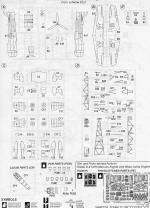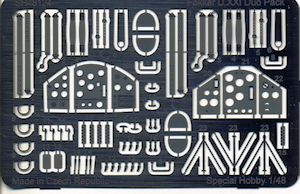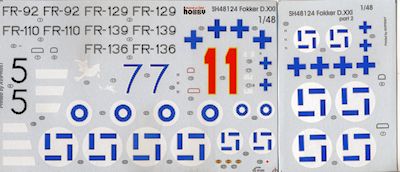
Special Hobby 1/48 Fokker D.XXI 'Finland'
| KIT #: | SH 48124 |
| PRICE: | $32.99 on sale ($70.99 SRP) |
| DECALS: | Six options |
| REVIEWER: | Scott Van Aken |
| NOTES: | Two complete kits |

| HISTORY |
In 1936 a few Fokker D.XXIs were used by the Spanish Republic. Although the order by the ML-KNIL was cancelled, the Luchtvaartafdeling (Dutch Army Air Force before World War II) placed an order of 36 aircraft, which were all delivered in time to participate in the war against the Germans in May 1940. The Fokker D.XXI, although much slower and more lightly armed than the Bf 109, performed surprisingly well in dogfights, due to its maneuverability. It was also one of the few aircraft that could follow a Stuka bomber into its dive. Nonetheless, the numerical inferiority of the Luchtvaartafdeling compared to the Luftwaffe resulted in the destruction of most Dutch Fokker D.XXI fighters during the campaign. Some were captured during and after 15 May, but their fates, apart from their capture, are unknown.
The Fokker D.XXI performed better and for much longer in the Finnish Air Force, which had acquired a number of licence-built fighters prior to the start of the Winter War. Against the aircraft of the Soviet Air Force, the Fokker was more evenly matched, and its rugged design with a radial engine and fixed undercarriage made it very suitable for Finnish conditions. Later in the war, as newer models of Soviet fighters appeared, the Fokker D.XXI was underpowered and too lightly armed (with only four 7.92 mm/.312 in machine guns) to compete. Plans to arm the Fokkers with 20 mm cannons were dropped and only one fighter was armed as such (two 20 mm cannons and two 7.92 mm/.312 in machine guns). Another fighter was equipped with retractable landing gear, but due to less than anticipated performance improvement, wasn't continued in the series. During the Continuation War (1941–44) the Finnish State Aircraft Factory (Valtion Lentokonetehdas, VL) also built some 50 D.XXIs with the Swedish-built Pratt & Whitney R-1535 Twin Wasp Junior as the Bristol Mercury was in short supply. These can be identified by their longer cockpit glazing, smooth cowl, and large ventral air intake under the cowl. The fixed undercarriage lent itself to both unimproved runways and conversion to skis for winter use, both of which were advantages in the Finnish theater.
Several Finnish Air Force pilots became fighter aces with the Fokker D.XXI. The top scoring Fokker ace was Jorma Sarvanto who obtained 12 5/6 victories with the type. Many other future aces scored at least one victory with the Fokker. The highest scoring airframe was FK-110, with 10 victories. This aircraft survived the war and is on display at the Central Finland Aviation Museum.
| THE KIT |
 I
can only assume that Special Hobby had a bunch of extra kits laying about
and so decided to combine a couple of them into a special boxing. This one
is all Finnish AF aircraft, which is quite appropriate, since one of the two
kits is a Wasp powered version that was only used by the Finns. Aside from
the difference in engines, cowlings and canopies (the Wasp powered one has
more transparencies aft of the pilot), the two kits are the same plastic.
I
can only assume that Special Hobby had a bunch of extra kits laying about
and so decided to combine a couple of them into a special boxing. This one
is all Finnish AF aircraft, which is quite appropriate, since one of the two
kits is a Wasp powered version that was only used by the Finns. Aside from
the difference in engines, cowlings and canopies (the Wasp powered one has
more transparencies aft of the pilot), the two kits are the same plastic.
 ects
from many Special Hobby kits, this one has a photo etch fret. In this case
it includes the pieces for both aircraft. You will notice that pretty much
everything is duplicated including the seat harness, rudder pedal straps,
instrument panels, cowling braces and some other small bits. Note that the
instrument panels are slightly different and designed for different types.
ects
from many Special Hobby kits, this one has a photo etch fret. In this case
it includes the pieces for both aircraft. You will notice that pretty much
everything is duplicated including the seat harness, rudder pedal straps,
instrument panels, cowling braces and some other small bits. Note that the
instrument panels are slightly different and designed for different types.
 Markings
are for six planes as shown on the box art. The three Mercury powered
options are for LeLv 12 and LeLv 24 with two of them in the overall upper
olive green scheme and one in the later version that included the black. All
three Wasp powered planes are in the later scheme with the one that does not
have the wheel spats being a post war plane. The decal sheets are nicely
printed and as expected, the insignia are in segments for those using the
swastika insignia. Those who have access to any of the Techmod Finnish
insignia sheets might find those to be a viable option to the kit versions.
Markings
are for six planes as shown on the box art. The three Mercury powered
options are for LeLv 12 and LeLv 24 with two of them in the overall upper
olive green scheme and one in the later version that included the black. All
three Wasp powered planes are in the later scheme with the one that does not
have the wheel spats being a post war plane. The decal sheets are nicely
printed and as expected, the insignia are in segments for those using the
swastika insignia. Those who have access to any of the Techmod Finnish
insignia sheets might find those to be a viable option to the kit versions.
| CONCLUSIONS |
I have to say that I would have overlooked this one were it not on sale. The two kits look to be quite well done and have all the detail you could ask for in a kit of this important plane. The kit does come with the smooth cowling used by Dutch aircraft, so there is no reason one of these could not be done if you have decals for it. Not sure if the Danish version could be built as there are no cannon included, but I'm not sure all of the small batch had these weapons. Anyway, if you are a fan of the aircraft or want the unique Finnish version, this would be worth seeking.
| REFERENCES |
http://en.wikipedia.org/wiki/Fokker_D.XXI
My thanks to, well, me for picking this one up. May 2013
If you would like your product reviewed fairly and fairly quickly, please contact the editor or see other details in the Note to Contributors.